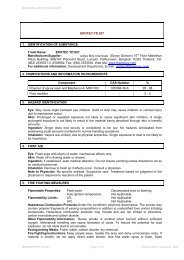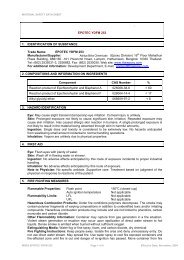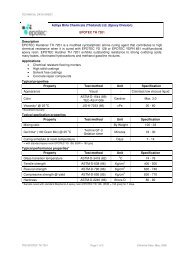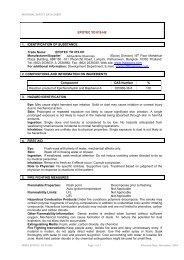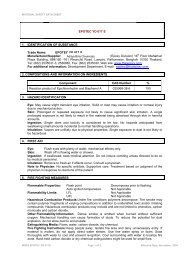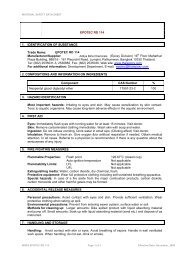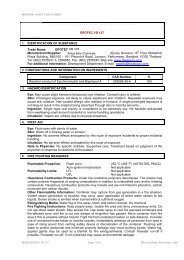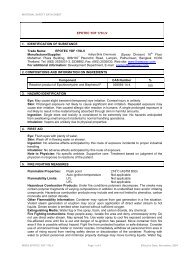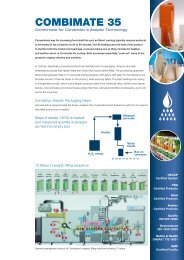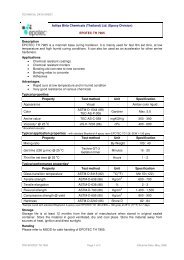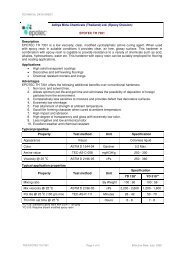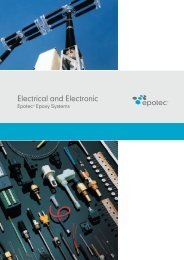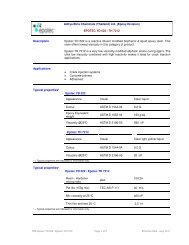Chlorine - Aditya Birla Chemicals
Chlorine - Aditya Birla Chemicals
Chlorine - Aditya Birla Chemicals
Create successful ePaper yourself
Turn your PDF publications into a flip-book with our unique Google optimized e-Paper software.
GRASIM INDUSTRIES LIMITED<br />
CHEMICAL DIVISION<br />
BIRLAGRAM, NAGDA (M.P.)<br />
MATERIAL SAFETY DATA SHEET<br />
PRODUCT NAME: CHLORINE<br />
1. Chemical Product and Company Identification<br />
GRASIM INDUSTRIES LIMITED<br />
CHEMICAL DIVISION<br />
BIRLAGRAM, NAGDA (M.P.) INDIA<br />
TEL. No. 07366-246760-66<br />
FAX NO. 091-7366-246767<br />
E-Mail: grasimchem@adityabirla.com<br />
PRODUCT NAME: CHLORINE<br />
CHEMICAL NAME: <strong>Chlorine</strong><br />
TDG (Canada) CLASSIFICATION: 2.3<br />
2. Composition, Information on Ingredients<br />
INGREDIENT % VOLUME PEL-OSHA 1 TLV-ACGIH 2<br />
<strong>Chlorine</strong><br />
FORMULA: Cl2<br />
CAS: 7782-50-5<br />
RTECS #: FO2100000<br />
100.0 1 ppm Ceiling 0.5 ppm TWA<br />
1 ppm STEL<br />
1<br />
As stated in 29 CFR 1910, Subpart Z (revised July 1, 1993)<br />
2<br />
As stated in the ACGIH 1994-95 Threshold Limit Values for Chemical Substances and Physical Agents<br />
LD50 or LC50<br />
Route/Species<br />
LC50<br />
293 ppm/1H<br />
(rat)<br />
3. Hazards Identification<br />
EMERGENCY OVERVIEW<br />
Corrosive and irritating to the eyes, skin and mucous membranes. Inhalation may result in<br />
chemical pneumonitis and pulmonary edema. Nonflammable. Oxidizer, may explode or<br />
accelerate combustion if contacting reducing agents.<br />
ROUTE OF ENTRY:<br />
Skin Contact Skin Absorption Eye Contact Inhalation Ingestion<br />
Yes No Yes Yes No<br />
HEALTH EFFECTS:<br />
Exposure Limits<br />
Irritant<br />
Yes<br />
Yes<br />
Teratogen<br />
Reproductive Hazard<br />
Yes<br />
Yes<br />
Synergistic Effects Other agents that irritate the respiratory system<br />
Carcinogenicity: -- NTP: No IARC: No OSHA: No<br />
Sensitization<br />
No<br />
Mutagen<br />
Yes<br />
EYE EFFECTS:<br />
Corrosive and irritating to the eyes. Contact with the liquid or vapor causes painful burns and ulcerations.<br />
Burns to the eyes result in lesions and possible loss of vision.
SKIN EFFECTS:<br />
Corrosive and irritating to the skin and all living tissue. It hydrolyzes very rapidly yielding hydrochloric<br />
acid. Skin burns and mucosal irritation are like that from exposure to volatile inorganic acids. <strong>Chlorine</strong><br />
burns exhibit severe pain, redness, possible swelling and early necrosis.<br />
INGESTION EFFECTS:<br />
Ingestion is unlikely.<br />
INHALATION EFFECTS:<br />
Corrosive and irritating to the upper and lower respiratory tract and all mucosal tissue. Symptoms include<br />
lacrimation, cough, labored breathing, and excessive salivary and sputum formation. Excessive irritation of<br />
the lungs causes acute pneumonitis and pulmonary edema, which could be fatal. Residual pulmonary<br />
malfunction may also occur. Chemical pneumonitis and pulmonary edema may result from exposure to the<br />
lower respiratory tract and deep lung.<br />
Some experimental evidence indicates chlorine causes mutagenic, teratogenic, and reproductive effects in<br />
animal studies.<br />
NFPA HAZARD CODES HMIS HAZARD CODES RATINGS SYSTEM<br />
Health: 4 Health: 4 0 = No Hazard<br />
Flammability: 0 Flammability: 0 1 = Slight Hazard<br />
Reactivity: 0 Reactivity: 0 2 = Moderate Hazard<br />
OXIDIZER<br />
3 = Serious Hazard<br />
4 = Severe Hazard<br />
4. First Aid Measures<br />
EYES:<br />
PERSONS WITH POTENTIAL EXPOSURE SHOULD NOT WEAR CONTACT LENSES. Flush<br />
contaminated eye(s) with copious quantities of water. Part eyelids to assure complete flushing. Continue for<br />
a minimum of 15 minutes. Seek immediate medical attention.<br />
SKIN:<br />
Remove contaminated clothing as rapidly as possible. Flush affected area with copious quantities of water.<br />
Seek immediate medical attention.<br />
INGESTION:<br />
None required.<br />
INHALATION:<br />
PROMPT MEDICAL ATTENTION IS MANDATORY IN ALL CASES OF OVEREXPOSURE.<br />
RESCUE PERSONNEL SHOULD BE EQUIPPED WITH SELF-CONTAINED BREATHING<br />
APPARATUS.<br />
Conscious persons should be assisted to an uncontaminated area and inhale fresh air. Unconscious persons<br />
should be moved to an uncontaminated area and given artificial resuscitation and supplemental oxygen.<br />
Assure that mucus or vomited material does not obstruct the airway by use of positional drainage. Delayed<br />
pulmonary edema may occur. Keep the patient under medical observation for at least 24 hours.<br />
5. Fire Fighting Measures<br />
Conditions of Flammability: Not flammable<br />
Flash point:<br />
Method:<br />
None<br />
Not Applicable<br />
LEL(%): None<br />
UEL(%): None<br />
Hazardous combustion products: None<br />
Sensitivity to mechanical shock: None<br />
Sensitivity to static discharge: None<br />
Autoignition<br />
Temperature: None
FIRE AND EXPLOSION HAZARDS:<br />
Combustible materials burn in chlorine as they do in oxygen.<br />
EXTINGUISHING MEDIA:<br />
None required. Use media suitable for surrounding materials.<br />
6. Accidental Release Measures<br />
Evacuate all personnel from affected area. Use appropriate protective equipment. If leak is in user’s<br />
equipment, be certain to purge piping with inert gas prior to attempting repairs. If leak is in container or<br />
container valve, contact the appropriate emergency telephone number listed in Section 1 or calls your<br />
closest BOC location.<br />
7. Handling and Storage<br />
Electrical classification:<br />
Nonhazardous.<br />
Most metals corrode rapidly with wet chlorine. Systems must be kept dry. Lead, gold, tantalum and<br />
Hastelloy are most resistant to wet chlorine.<br />
Use only in well-ventilated areas. Valve protection caps must remain in place unless container is secured<br />
with valve outlet piped to use point. Do not drag, slide or roll cylinders. Use a suitable hand truck for<br />
cylinder movement. Use a pressure reducing regulator when connecting cylinder to lower pressure (
OTHER/GENERAL PROTECTION:<br />
Safety shoes, safety shower, eyewash "fountain", face shield.<br />
9. Physical and Chemical Properties<br />
PARAMETER VALUE UNITS<br />
Physical state (gas, liquid, solid) :<br />
Gas<br />
Vapor pressure at 70 o F : 100.2 psia<br />
Vapor density at STP (Air = 1) : 2.47<br />
Evaporation point :<br />
Not Available<br />
Boiling point : -29.3<br />
o F<br />
: -34.1<br />
o C<br />
Freezing point : -149.8<br />
o F<br />
: -101<br />
o C<br />
pH :<br />
Specific gravity :<br />
Oil/water partition coefficient :<br />
Solubility (H 2 0) :<br />
Odor threshold :<br />
Odor and appearance :<br />
10. Stability and Reactivity<br />
STABILITY:Stable<br />
Not Available<br />
Not Available<br />
Not Available<br />
1% at 9.4 o C<br />
Not Available<br />
Greenish-yellow gas with sharp suffocating odor.<br />
Liquid is amber colored.<br />
INCOMPATIBLE MATERIALS:<br />
Hydrocarbons, ammonia, ether, hydrogen, acetylene, turpentine, powdered metals and other reducing<br />
agents.<br />
HAZARDOUS POLYMERIZATION:<br />
Will not occur.<br />
11. Toxicological Information<br />
TUMORIGENIC:<br />
Evidence of carcinogenic activity in experimental rats exposed orally.<br />
REPRODUCTIVE:<br />
Embryo and fetotoxicity observed after exposure of female rats exposed at 565 mg/kg prior to mating.<br />
Effects also observed from exposure of pregnant rats at same level.<br />
MUTAGENIC:<br />
Mutagenic effects seen in bacterial, mammalian and insect assay systems.<br />
OTHER:<br />
Toxic effects reported in renal system, blood and spleen from inhalation exposure of rats.<br />
12. Ecological Information<br />
No data given.<br />
13. Disposal Considerations<br />
Do not attempt to dispose of residual waste or unused quantities. Return in the shipping container<br />
PROPERLY LABELED, WITH ANY VALVE OUTLET PLUGS OR CAPS SECURED AND VALVE<br />
PROTECTION CAP IN PLACE to BOC Gases or authorized distributor for proper disposal.
14. Transport Information<br />
PARAMETER United States DOT Canada TDG<br />
PROPER SHIPPING NAME: <strong>Chlorine</strong> <strong>Chlorine</strong><br />
HAZARD CLASS: 2.3 2.3 (5.1)<br />
IDENTIFICATION NUMBER: UN 1017 UN 1017<br />
SHIPPING LABEL: POISON GAS, CORROSIVE POISON GAS, OXIDIZER<br />
Additional Marking Requirement: “Inhalation Hazard”<br />
If net weight of product > 10 pounds, the container must be also marked with the letters “RQ”.<br />
Additional Shipping Paper Description Requirement: “Poison-Inhalation Hazard, Zone B”<br />
If net weight of product > 10 pounds, the shipping papers must be also marked with the letters “RQ”.<br />
15. Regulatory Information<br />
<strong>Chlorine</strong> is listed under the accident prevention provisions of section 112(r) of the Clean Air Act (CAA)<br />
with a threshold quantity (TQ) of 2,500 pounds.<br />
SARA TITLE III NOTIFICATIONS AND INFORMATION<br />
<strong>Chlorine</strong> is listed as an extremely hazardous substance (EHS) subject to state and local reporting under<br />
Section 304 of SARA Title III (EPCRA).<br />
The presence of chlorine in quantities in excess of the threshold planning quantity (TPQ) of 100 pounds<br />
requires certain emergency planning activities to be conducted.<br />
Releases of chlorine in quantities equal to or greater than the reportable quantity (RQ) of 10 pounds are<br />
subject to reporting to the National Response Center under CERCLA, Section 304 SARA Title III.<br />
SARA TITLE III - HAZARD CLASSES:<br />
Acute Health Hazard<br />
Chronic Health Hazard<br />
Fire Hazard<br />
Sudden Release of Pressure Hazard<br />
Reactivity Hazard<br />
SARA TITLE III - SECTION 313 SUPPLIER NOTIFICATION:<br />
This product contains the following toxic chemicals subject to the reporting requirements of section 313 of<br />
the Emergency Planning and Community Right-To-Know Act (EPCRA) of 1986 and of 40 CFR 372:<br />
CAS NUMBER INGREDIENT NAME PERCENT BY VOLUME<br />
7782-50-5 CHLORINE 100.0<br />
This information must be included on all MSDSs that are copied and distributed for this material.<br />
16. Other Information<br />
Compressed gas cylinders shall not be refilled without the express written permission of the owner.<br />
Shipment of a compressed gas cylinder which has not been filled by the owner or with his/her (written)<br />
consent is a violation of transportation regulations.<br />
DISCLAIMER OF EXPRESSED AND IMPLIED WARRANTIES:<br />
Above "Material Safety Date Sheet" is for information only. GRASIM INDUSTRIES LIMITED, Chemical<br />
Division does not take any guarantee or legal liability under any circumstances for the same. The Physical<br />
data presented herein does not purport to be the specifications.



